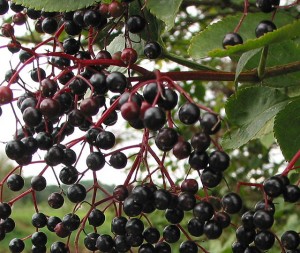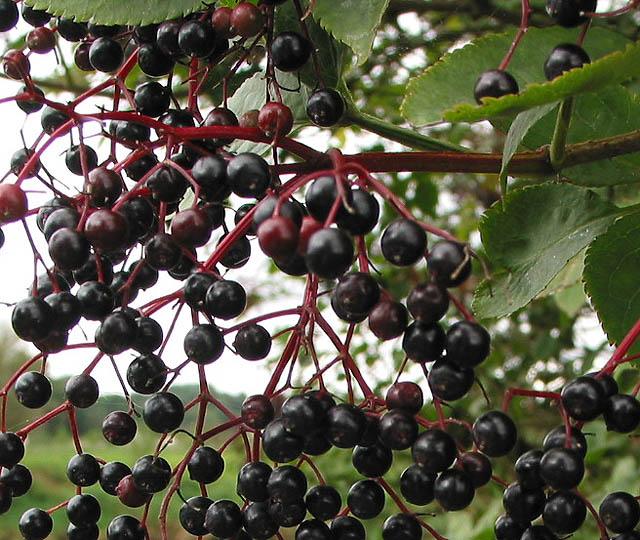 Elderberry plants have long been a part of human history, sometimes with a good reputation and other times with a bad reputation. Elderberries have been used in tarts, cobblers, pies, jams, jellies, and wine, to name just a few applications.
Elderberry plants have long been a part of human history, sometimes with a good reputation and other times with a bad reputation. Elderberries have been used in tarts, cobblers, pies, jams, jellies, and wine, to name just a few applications.
Many parts of the elderberry plant have been used medicinally, though we now know that most parts of the plant contain toxins, most especially in the roots, stems, and leaves. Flowers used in tea, in moderation, seem to have no ill effect. Limited amounts of raw berries, eaten raw, seem to have little effect, though some may experience negative effects, depending on how much is eaten. It is not recommended to allow children to eat from the bushes unattended.
Ripe berries, when cooked, lose their toxicity and have been found to have health benefits. This is particularly true of black elderberry, also known as Sambucus nigra or European elder. It is important to note that red elderberries are far more toxic than the other varieties and are best left alone.
Identification
Black elderberry is a common plant to find growing in the wild and alongside buildings, especially where moisture tends to collect. Old barns, farmhouses, and outbuildings often have elderberries next to them. The plants grow in a small tree-like manner or appear to be bushes or shrubs, as their roots branch out and send up new shoots of growth. The leaves of the black elderberry grow opposite each other, usually in groups of five—two groups of two leaves opposite each other and one leaf at the end of the stem. In spring, the plants produce white flowers in flat-topped terminal clusters. They look somewhat like a white-topped umbrella. Later in the season, these flowers are replaced by the berries, which ripen to a glossy dark purple-black as the stalks turn dark red and hang downward due to the weight of the berries.
How To Harvest Elderberries
An easy way to harvest elderberries involves a wide toothed comb. Cut the heads of ripe berries from the plant and find a comfortable place to sit. Over a large bowl, use the wide toothed comb to comb the berries off of the stems. It is important to get as much of the stem out of your berry bowl as possible, to eliminate as much of the toxins as possible. A little bit won’t hurt, but why push it?
Once your elderberries are picked from the stems, rinse them and spread them on a towel to dry. Then, use in your recipes or freeze. I find it useful to freeze the berries on a jellyroll pan on wax paper or foil and after they are frozen, to bag them up in freezer bags. This allows me to measure out the amount I need at a later time, rather than having to thaw a whole container that is a solid frozen clump of berries.
Another option is to dry them in a food dehydrator or a warm oven with the door ajar.
Black Elderberry As Medicine: How Does It Work?
Black elderberries are full of antioxidants, a characteristic many dark-colored fruits and vegetables share. Antioxidants help the body in dealing with free radicals we come into contact with in our environment, as well as assisting our immune systems.
Studies have also shown that black elderberry stimulates the immune system by increasing lymphocytes, a part of the immune system that fights disease. This helps in fighting off cold and flu viruses.
Black elderberry has been shown to aid in fighting off the flu virus in other ways as well. The flu virus, under a microscope, has spikes that project out from it, and with these spikes, it pierces the wall of healthy cells in order to reproduce. Black elderberry, when taken into the body, has the ability to flatten the virus’ spikes, rendering it incapable of reproducing and preventing the body from getting the full-blown flu virus.
Elderberry extract appears to be the best method of getting the benefits of elderberry during cold and flu season. Apparently, your grandma’s elderberry cobbler won’t give you the same benefits. You can purchase elderberry extract or syrup, or you can make your own elderberry syrup.
Learn How You Can Make Powerful Herbal Medicines Secretly in Your Kitchen
How To Make Your Own Elderberry Syrup
To make your own elderberry syrup, you must first gather your supplies. If you are not confident in harvesting your own elderberries or do not have access to them, they may be purchased online or perhaps from your local health food store.
To make approximately one quart of elderberry syrup, you will need:
- 1 cup fresh black elderberries (1/2 cup if you are using dried)
- 3 cups of water
- 1 cup honey (no additives or fillers, please)*
- Cinnamon sticks or cloves, if desired
- Saucepan
- Metal spoon
- Strainer
- Cheesecloth
- Quart jar, preferably sterilized
*If the syrup is intended for children under one year old, you may want to find an alternative sweetener source or another method of warding off illness, as honey can contain botulism spores, something that young digestive systems aren’t equipped to handle.
Directions:
1. Put your black elderberries and water in your pan and bring to a boil. (If you have chosen to add cinnamon or cloves, add them in now.)
2. Simmer gently, about forty-five minutes.
3. Mash the berries well.
4. Strain the berries. This is where a cheesecloth comes in handy, as you can lay the cheesecloth in the strainer, pour the berry mixture in, and get most of the water out, then lift the cheesecloth, twist the ends together, and gently squeeze the remaining liquid through the strainer to get as much of the goodness out of the berries as possible.
5. Pour off ½ cup of the black elderberry juice into a small bowl with the honey and mix until dissolved.
6. Pour the honey mixture into the rest of the black elderberry juice and stir.
7. Pour into a jar and refrigerate. It should last at least one month in the fridge.
Adult dosage is one tablespoon every three to four hours; child dosage is one-half to one teaspoon every three to four hours when you or your family member is fighting off illness. Elderberry syrup may also be taken daily as a preventative, with the above dosages given once a day.
Enjoy!
Please note, I am not a doctor and this is not intended as medical advice. I am simply sharing methods that have been used and information that has been passed on over the years. If you need medical assistance or advice, please see your physician. Always check with your physician before starting any treatment.
©2012 Off the Grid News











